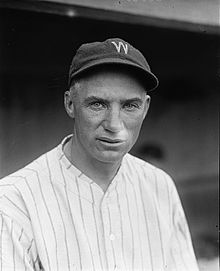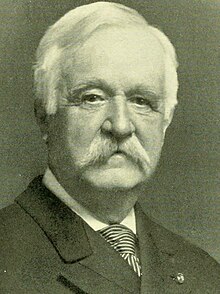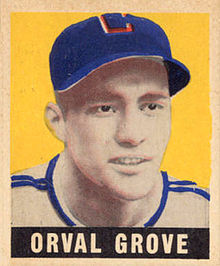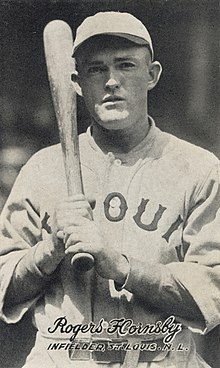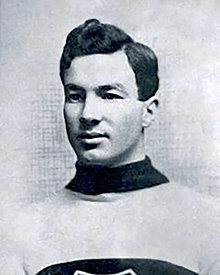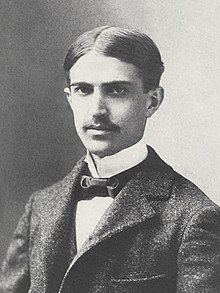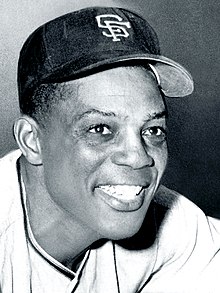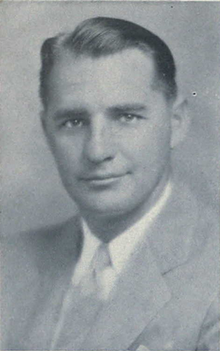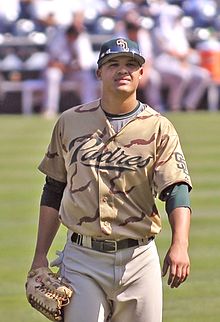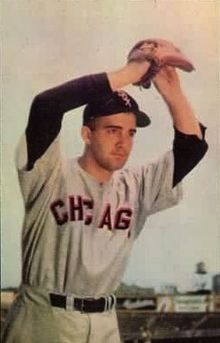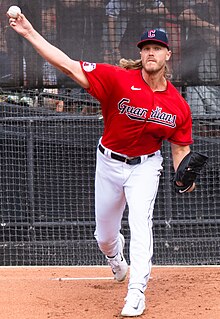Portal:Baseball
Portal maintenance status: (June 2018)
|
| Main page | Content, Categories & Topics | WikiProjects & Things you can do |
The Baseball Portal
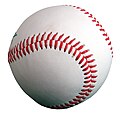
Baseball is a bat-and-ball sport played between two teams of nine players each, taking turns batting and fielding. The game occurs over the course of several plays, with each play generally beginning when a player on the fielding team, called the pitcher, throws a ball that a player on the batting team, called the batter, tries to hit with a bat. The objective of the offensive team (batting team) is to hit the ball into the field of play, away from the other team's players, allowing its players to run the bases, having them advance counter-clockwise around four bases to score what are called "runs". The objective of the defensive team (referred to as the fielding team) is to prevent batters from becoming runners, and to prevent runners advancing around the bases. A run is scored when a runner legally advances around the bases in order and touches home plate (the place where the player started as a batter).
The opposing teams switch back and forth between batting and fielding; the batting team's turn to bat is over once the fielding team records three outs. One turn batting for each team constitutes an inning. A game is usually composed of nine innings, and the team with the greater number of runs at the end of the game wins. Most games end after the ninth inning, but if scores are tied at that point, extra innings are usually played. Baseball has no game clock, though some competitions feature pace-of-play regulations such as the pitch clock to shorten game time.
Baseball evolved from older bat-and-ball games already being played in England by the mid-18th century. This game was brought by immigrants to North America, where the modern version developed. Baseball's American origins, as well as its reputation as a source of escapism during troubled points in American history such as the American Civil War and the Great Depression, have led the sport to receive the moniker of "America's Pastime"; since the late 19th century, it has been unofficially recognized as the national sport of the United States, though in modern times is considered less popular than other sports, such as American football. In addition to North America, baseball spread throughout the rest of the Americas and the Asia–Pacific in the 19th and 20th centuries, and is now considered the most popular sport in parts of Central and South America, the Caribbean, and East Asia, particularly in Japan, South Korea, and Taiwan. (Full article...)
 Featured articles - load new batch
Featured articles - load new batch
-
Image 1

KARE (channel 11) is a television station licensed to Minneapolis, Minnesota, United States, serving as the Twin Cities area's NBC affiliate. Owned by Tegna Inc., the station maintains studios on Olson Memorial Highway (MN 55) in Golden Valley and a transmitter at the Telefarm site in Shoreview, Minnesota.
Channel 11 began broadcasting on September 1, 1953. It was originally shared by WMIN-TV in St. Paul and WTCN-TV in Minneapolis; the two stations shared an affiliation with ABC and alternated presenting local programs. In 1955, Consolidated Television and Radio bought both stations and merged them as WTCN-TV from the Minneapolis studios in the Calhoun Beach Hotel. The station presented several regionally and nationally notable children's shows in its early years as well as local cooking, news, and sports programs. Time Inc. purchased the station in 1957. Under its ownership, ABC switched its affiliation to KMSP-TV (channel 9), leaving channel 11 to become an independent station that broadcast games of the Minnesota Twins baseball team, movies, and syndicated programs. This continued under two successive owners: Chris-Craft Industries and Metromedia. By the late 1970s, WTCN was one of the nation's most financially successful independent stations. (Full article...) -
Image 2The 2009 World Series was the championship series of Major League Baseball's (MLB) 2009 season. As the 105th edition of the World Series, it was a best-of-seven playoff contested between the Philadelphia Phillies, champions of the National League (NL) and defending World Series champions, and the New York Yankees, champions of the American League (AL). The Yankees defeated the Phillies, 4 games to 2, winning their 27th World Series championship.
The series was played between October 28 and November 4, broadcast on Fox, and watched by an average of roughly 19 million viewers. Home field advantage for the Series went to the AL for the eighth straight year as a result of its 4–3 win in the All-Star Game. The Phillies earned their berth into the playoffs by winning the National League East. The Yankees won the American League East to earn their berth, posting the best record in the Major Leagues. The Phillies reached the World Series by defeating the Colorado Rockies in the best-of-five National League Division Series and the Los Angeles Dodgers in the best-of-seven NL Championship Series (NLCS). The Yankees defeated the Minnesota Twins in the American League Division Series and the Los Angeles Angels of Anaheim in the AL Championship Series (ALCS) to advance to their first World Series since 2003. As a result of their loss, the Phillies became the first team since the 2001 Yankees to lose the World Series after winning it the previous year. As of 2024, this is the most recent World Series to feature a defending champion. (Full article...) -
Image 3

WSNS-TV (channel 44) is a television station in Chicago, Illinois, United States, serving as the local outlet for the Spanish-language network Telemundo. It is owned and operated by NBCUniversal's Telemundo Station Group alongside NBC outlet WMAQ-TV (channel 5). The two stations share studios at the NBC Tower on North Columbus Drive in the city's Streeterville neighborhood and broadcast from the same transmitter atop the Willis Tower in the Chicago Loop.
WSNS-TV began broadcasting in 1970. Originally specializing in the automated display of news headlines, it evolved into Chicago's third full-fledged independent station, carrying movies, local sports, and other specialty programming. This continued until 1980, when WSNS became the Chicago-area station for ON TV, an over-the-air subscription television (STV) service owned by Oak Industries, which took a minority ownership stake in the station. While ON TV was successful in Chicago and the subscription system became the second-largest in the country by total subscribers, the rise of cable television precipitated the end of the business in 1985, with WSNS-TV as the last ON TV station standing. (Full article...) -
Image 4
Stanley Anthony Coveleski (born Stanislaus Kowalewski, July 13, 1889 – March 20, 1984) was an American right-handed pitcher in Major League Baseball who played for four American League (AL) teams between 1912 and 1928, primarily the Cleveland Indians. The star of the Indians pitching staff, he won over 20 games each year from the war-shortened 1918 season through 1921, leading the AL in shutouts twice and in strikeouts and earned run average (ERA) once each during his nine years with the club. The star of the 1920 World Series, he led the Indians to their first title with three complete-game victories, including a 3–0 shutout in the Game 7 finale. Traded to the Washington Senators after the 1924 season, he helped that club to its second AL pennant in a row with 20 victories against only 5 losses, including a 13-game winning streak, while again leading the league in ERA.
Coveleski followed in the footsteps of his brother Harry as a major league pitcher. But after making his debut with the Philadelphia Athletics in 1912, he was sidetracked by three more seasons in the minor leagues before joining the Indians in 1916, and won only 13 major league games before turning 27. Coveleski specialized in throwing the spitball, where the pitcher alters the ball with a foreign substance such as chewing tobacco. It was legal when his career began but prohibited in 1920, with Coveleski being one of 17 pitchers permitted to continue throwing the pitch. In 450 career games, Coveleski pitched 3,082 innings and posted a record of 215–142, with 224 complete games, 38 shutouts, and a 2.89 ERA. He set Cleveland records of 172 wins, 2,502+1⁄3 innings and 305 starts, which were later broken by Mel Harder and Willis Hudlin. He was inducted into the Baseball Hall of Fame in 1969. (Full article...) -
Image 5
Tyler Wayne Skaggs (July 13, 1991 – July 1, 2019) was an American left-handed professional baseball starting pitcher who played in Major League Baseball (MLB) for the Arizona Diamondbacks and Los Angeles Angels from 2012 until his death in 2019.
A native of Woodland Hills, California, and a graduate of Santa Monica High School, Skaggs was a supplemental first-round selection for the Angels in the 2009 Major League Baseball draft. He was traded to the Diamondbacks the following year as part of an exchange for pitcher Dan Haren and rose through Arizona's farm system. After two consecutive appearances at the All-Star Futures Game in 2011 and 2012, Skaggs made his major league debut on August 22, 2012, against the Miami Marlins. He remained with the Diamondbacks through the end of the season, but was optioned to the minor leagues in 2013. (Full article...) -
Image 6Disco Demolition Night was a Major League Baseball (MLB) promotion on Thursday, July 12, 1979, at Comiskey Park in Chicago, Illinois, that ended in a riot. At the climax of the event, a crate filled with disco records was blown up on the field between games of the twi-night doubleheader between the Chicago White Sox and the Detroit Tigers. Many had come to see the explosion rather than the games and rushed onto the field after the detonation. The playing field was so damaged by the explosion and by the rioters that the White Sox were required to forfeit the second game to the Tigers.
In the late 1970s, dance-oriented disco was the most popular music genre in the United States, particularly after being featured in hit films such as Saturday Night Fever (1977). However, disco sparked a major backlash from rock music fans—an opposition prominent enough that the White Sox, seeking to fill seats at Comiskey Park during a lackluster season, engaged Chicago shock jock and anti-disco campaigner Steve Dahl for the promotion at the July 12 doubleheader. Dahl's sponsoring radio station was WLUP (97.9 FM, now WCKL), so admission was discounted to 98 cents for attendees who turned in a disco record; between games, Dahl was to destroy the collected vinyl in an explosion. (Full article...) -
Image 7
Charles Dillon "Casey" Stengel (/ˈstɛŋɡəl/; July 30, 1890 – September 29, 1975) was an American Major League Baseball right fielder and manager, best known as the manager of the championship New York Yankees of the 1950s and later, the expansion New York Mets. Nicknamed "the Ol' Perfessor", he was elected to the Baseball Hall of Fame in 1966.
Stengel was born in Kansas City, Missouri, in 1890. In 1910, he began a professional baseball career that would span over half a century. After almost three seasons in the minor leagues, Stengel reached the major leagues late in 1912, as an outfielder, for the Brooklyn Dodgers. His six seasons there saw some success, among them playing for Brooklyn's 1916 National League championship team, but he also developed a reputation as a clown. After repeated clashes over pay with the Dodgers owner, Charlie Ebbets, Stengel was traded to the Pittsburgh Pirates in 1918; however, he enlisted in the Navy that summer, for the remainder of World War I. After returning to baseball, he continued his pay disputes, resulting in trades to the Philadelphia Phillies (in 1919) and to the New York Giants (in 1921). There, he learned much about baseball from the manager, John McGraw, and had some of the glorious moments in his career, such as hitting an inside-the-park home run in Game 1 of the 1923 World Series to defeat the Yankees. His major league playing career ended with the Boston Braves in 1925, but he then began a career as a manager. (Full article...) -
Image 8
Morgan Gardner Bulkeley (December 26, 1837 – November 6, 1922) was an American politician of the Republican Party, businessman, and insurance executive. In 1876, he served as the first president of baseball's National League and, because of that, was inducted into the National Baseball Hall of Fame in 1937, a choice that remains controversial, since his time as a baseball executive was short.
Bulkeley was born in East Haddam, Connecticut. His father was Judge Eliphalet Adams Bulkeley, a prominent local lawyer and businessman, who became the first president of the Aetna Life Insurance Company. The family moved to Hartford, where Morgan Bulkeley was educated, before he took a job in the city of Brooklyn, New York. He served briefly in the American Civil War, where he saw no combat. When his father died in 1872, he moved back to Hartford and became a bank president and a board member of Aetna, becoming its president in 1879, a post he held the rest of his life. (Full article...) -
Image 9
Orval Leroy Grove (August 29, 1919 – April 20, 1992) was an American professional baseball pitcher in Major League Baseball who played for ten seasons in the American League with the Chicago White Sox. In 207 career games, Grove pitched 1,176 innings and posted a win–loss record of 63–73, with 66 complete games, 11 shutouts, and a 3.78 earned run average (ERA).
The only freshman on the Proviso Township High School varsity baseball team, Grove's pitching ability attracted the attention of the White Sox. After signing with the team in 1937, Grove moved between the major leagues and minor leagues for a few seasons until 1943, when he found a solid place in the White Sox's pitching rotation. Grove had a career-year in 1943, finishing the season with career-bests in ERA, wins, and complete games; in 1944, he made his only All-Star appearance. (Full article...) -
Image 10
Robert William Andrew Feller (November 3, 1918 – December 15, 2010), nicknamed "the Heater from Van Meter", "Bullet Bob", and "Rapid Robert", was an American baseball pitcher who played 18 seasons in Major League Baseball (MLB) for the Cleveland Indians between 1936 and 1956. In a career spanning 570 games, Feller pitched 3,827 innings and posted a win–loss record of 266–162, with 279 complete games, 44 shutouts, and a 3.25 earned run average (ERA). His career 2,581 strikeouts were third all-time upon his retirement.
A prodigy who bypassed baseball's minor leagues, Feller made his debut with the Indians at the age of 17. His career was interrupted by four years of military service (1942–1945) as a United States Navy Chief Petty Officer aboard USS Alabama during World War II. Feller became the first pitcher to win 24 games in a season before the age of 21. He threw no-hitters in 1940, 1946, and 1951, and 12 one-hitters, both records at his retirement. He helped the Indians win a World Series title in 1948 and an American League-record 111 wins and the pennant in 1954. Feller led the American League in wins six times and in strikeouts seven times. In 1946 he recorded 348 strikeouts, the most since 1904 and then believed to be a record. (Full article...) -
Image 11
Mariano Rivera (born November 29, 1969) is a Panamanian-American former professional baseball pitcher who played 19 seasons in Major League Baseball (MLB) for the New York Yankees, from 1995 to 2013. Nicknamed "Mo" and "Sandman", he spent most of his career as a relief pitcher and served as the Yankees' closer for 17 seasons. A thirteen-time All-Star and five-time World Series champion, he is MLB's career leader in saves (652) and games finished (952). Rivera won five American League (AL) Rolaids Relief Man Awards and three Delivery Man of the Year Awards, and he finished in the top three in voting for the AL Cy Young Award four times. In 2019, he was inducted into the Baseball Hall of Fame in his first year of eligibility, and is to date the only player ever to be elected unanimously by the Baseball Writers' Association of America (BBWAA).
Raised in the modest Panamanian fishing village of Puerto Caimito, Rivera was an amateur player until he was signed by the Yankees organization in 1990. He debuted in the major leagues in 1995 as a starting pitcher, before permanently converting to a relief pitcher late that year. After a breakthrough season in 1996 as a setup man, he became the Yankees' closer in 1997. In the following seasons, he established himself as one of baseball's top relievers, leading the major leagues in saves in 1999, 2001, and 2004. Rivera primarily threw a sharp-moving, mid-90s mile-per-hour cut fastball that frequently broke hitters' bats and earned a reputation as one of the league's toughest pitches to hit. With his presence at the end of games, signaled by his foreboding entrance song "Enter Sandman", Rivera was a key contributor to the Yankees' dynasty in the late 1990s and early 2000s that won four championships in five years. He was an accomplished postseason performer, winning the 1999 World Series Most Valuable Player (MVP) Award and the 2003 AL Championship Series MVP Award, while setting postseason records that included lowest earned run average (ERA) (0.70) and most saves (42). (Full article...) -
Image 12
Rogers Hornsby (April 27, 1896 – January 5, 1963), nicknamed "the Rajah", was an American baseball infielder, manager, and coach who played 23 seasons in Major League Baseball (MLB). He played for the St. Louis Cardinals (1915–1926, 1933), New York Giants (1927), Boston Braves (1928), Chicago Cubs (1929–1932), and St. Louis Browns (1933–1937). He was named the National League (NL)'s Most Valuable Player (MVP) twice, and was a member of one World Series championship team.
Born in Winters, Texas, and raised in Fort Worth, Texas, Hornsby played for several semi-professional and minor league teams. In 1915, he began his major league career with the St. Louis Cardinals and remained with the team for 12 seasons. During this period, Hornsby won his first MVP Award and the Cardinals won the 1926 World Series. After that season, he spent one season with the New York Giants and another with the Boston Braves before being traded to the Chicago Cubs. He played with the Cubs for four years and won his second MVP Award before the team released him in 1932. Hornsby re-signed with the Cardinals in 1933, but was released partway through the season, effectively ending his career as a full-time player. He was picked up by the St. Louis Browns and remained there until his final season in 1937, though he made only 67 appearances for them as a player. From 1925 to 1937, Hornsby was intermittently a player-manager. After retiring as a player, he managed the Browns in 1952 and the Cincinnati Reds from 1952 to 1953. (Full article...) -
Image 13Ross with the Montreal Wanderers, circa 1907–18
Arthur Howey Ross (January 13, 1885 – August 5, 1964) was a Canadian professional ice hockey player and executive from 1905 until 1954. Regarded as one of the best defenders of his era by his peers, he was one of the first to skate with the puck up the ice rather than pass it to a forward. He was on Stanley Cup championship teams twice in a playing career that lasted thirteen seasons; in January 1907 with the Kenora Thistles and 1908 with the Montreal Wanderers. Like other players of the time, Ross played for several different teams and leagues, and is noted for his time with the Wanderers while they were members of the National Hockey Association (NHA) and its successor, the National Hockey League (NHL). In 1911, he led one of the first organized player strikes over increased pay. When the Wanderers' home arena burned down in January 1918, the team ceased operations and Ross retired as a player.
After several years as an on-ice official, he was named head coach of the Hamilton Tigers for one season. When the Boston Bruins were formed in 1924, Ross was hired as the first coach and general manager of the team. He later coached the team on three separate occasions until 1945, and stayed as general manager until his retirement in 1954. Ross helped the Bruins finish first place in the league ten times and win the Stanley Cup three times; Ross personally coached the team to two of those victories. After being hired by the Bruins, Ross, along with his wife and two sons, moved to a suburb of Boston, and he became an American citizen in 1938. He died near Boston in 1964. (Full article...) -
Image 14

Depiction of the game from The Boston Globe
On Saturday, May 1, 1920, the Brooklyn Dodgers and the Boston Braves played to a 1–1 tie in 26 innings, the most innings ever played in a single game in the history of Major League Baseball (MLB). The game was played at Braves Field in Boston before a crowd estimated at 4,000. Both Leon Cadore of Brooklyn and Joe Oeschger of Boston pitched complete games, and with 26 innings pitched, jointly hold the record for the longest pitching appearance in MLB history. Their record is considered unbreakable, as modern pitchers rarely pitch even nine innings, and newer baseball rules have made long extra-innings games a rarity.
The day of the game saw rainy weather, and it was uncertain if the game would be played, but the skies cleared enough to allow it to proceed. Brooklyn scored a run in the fifth inning, and Boston in the sixth; thereafter, the pitchers became increasingly dominant. As the game exceeded eighteen innings, the small crowd at Braves Field cheered both pitchers. The last twenty innings were scoreless, and when darkness started to fall, the umpires called a halt after the twenty-sixth inning, as baseball fields did not yet have artificial lighting. (Full article...) -
Image 15
Stephen Crane (November 1, 1871 – June 5, 1900) was an American poet, novelist, and short story writer. Prolific throughout his short life, he wrote notable works in the Realist tradition as well as early examples of American Naturalism and Impressionism. He is recognized by modern critics as one of the most innovative writers of his generation.
The ninth surviving child of Methodist parents, Crane began writing at the age of four and had several articles published by 16. Having little interest in university studies though he was active in a fraternity, he left Syracuse University in 1891 to work as a reporter and writer. Crane's first novel was the 1893 Bowery tale Maggie: A Girl of the Streets, generally considered by critics to be the first work of American literary Naturalism. He won international acclaim for his Civil War novel The Red Badge of Courage (1895), considered a masterpiece by different critics and writers. (Full article...)
General images - load new batch
-
Image 1The strike zone, which determines the outcome of most pitches, varies in vertical length depending on the batter's typical height while swinging. (from Baseball rules)
-
Image 2Pitchers are generally substituted during mound visits (team gatherings at the pitcher's mound). (from Baseball rules)
-
Image 32013 World Baseball Classic championship match between the Dominican Republic and Puerto Rico, March 20, 2013 (from Baseball)
-
Image 4Sadaharu Oh managing the Japan national team in the 2006 World Baseball Classic. Playing for the Central League's Yomiuri Giants (1959–80), Oh set the professional world record for home runs with 868. (from History of baseball)
-
Image 6Cover of Official Base Ball Rules, 1921 edition, used by the American League and National League (from Baseball rules)
-
Image 7By the 1860s Civil War, baseball (bottom) had overtaken its fellow bat-and-ball sport cricket (top) in popularity within the United States. (from History of baseball)
-
Image 8A game from the Cantigas de Santa Maria, c. 1280, involving tossing a ball, hitting it with a stick and competing with others to catch it (from History of baseball)
-
Image 9Pick-off attempt on runner (in red) at first base (from Baseball rules)
-
Image 10A New York Yankees batter (Andruw Jones) and a Boston Red Sox catcher at Fenway Park (from Baseball)
-
Image 11A first baseman receives a pickoff throw, as the runner dives back to first base. (from Baseball)
-
Image 12The American Tobacco Company's line of baseball cards featured shortstop Honus Wagner of the Pittsburgh Pirates from 1909 to 1911. In 2007, the card shown here sold for $2.8 million. (from Baseball)
-
Image 13Two players on the baseball team of Tokyo, Japan's Waseda University in 1921 (from Baseball)
-
Image 14The NL champion New York Giants baseball team, 1913. Fred Merkle, sixth in line, had committed a baserunning gaffe in a crucial 1908 game that became famous as Merkle's Boner. (from History of baseball)
-
Image 16Defensive positions on a baseball field, with abbreviations and scorekeeper's position numbers (not uniform numbers) (from Baseball)
-
Image 17A pitcher handing off the ball after being taken out of the game during a mound meeting. (from Baseball)
-
Image 19The strike zone determines the result of most pitches, and varies in vertical length for each batter. (from Baseball)
-
Image 21In May 2010, the Philadelphia Phillies' Roy Halladay pitched the 20th major league perfect game. That October, he pitched only the second no-hitter in MLB postseason history. (from History of baseball)
-
Image 23Fenway Park, home of the Boston Red Sox. The Green Monster is visible beyond the playing field on the left. (from Baseball)
-
Image 251906 World Series, infielders playing "in" for the expected bunt and the possible play at the plate with the bases loaded (from Baseball rules)
-
Image 26Jackie Robinson in 1945, with the era's Kansas City Royals, a barnstorming squad associated with the Negro American League's Kansas City Monarchs (from Baseball)
-
Image 28Jackie Robinson in 1945, with the era's Kansas City Royals, a barnstorming squad associated with the Negro American League's Kansas City Monarchs (from History of baseball)
-
Image 29A batter follows through after swinging at a pitched ball. (from Baseball rules)
-
Image 30The typical motion of a right-handed pitcher (from Baseball rules)
-
Image 31The standard fielding positions (from Baseball rules)
-
Image 32Baseball games sometimes end in a walk-off home run, with the batting team usually gathering at home plate to celebrate the scoring of the winning run(s). (from Baseball rules)
-
Image 33Alexander Cartwright, father of modern baseball (from History of baseball)
-
Image 34Japanese-Americans spectating a World War II-era game while in an internment camp. America's ties to immigrants and to Japan have been deeply shaped by a shared baseball heritage. (from History of baseball)
-
Image 35Rickey Henderson—the major leagues' all-time leader in runs and stolen bases—stealing third base in a 1988 game (from Baseball)
-
Image 36Diagram of a baseball field Diamond may refer to the square area defined by the four bases or to the entire playing field. The dimensions given are for professional and professional-style games. Children often play on smaller fields. (from Baseball)
-
Image 37Cy Young—the holder of many major league career marks, including wins and innings pitched, as well as losses—in 1908. MLB's annual awards for the best pitcher in each league are named for Young. (from Baseball)
-
Image 38A well-worn baseball (from Baseball)
-
Image 41Pesäpallo, a Finnish variation of baseball, was invented by Lauri "Tahko" Pihkala in the 1920s, and after that, it has changed with the times and grown in popularity. Picture of Pesäpallo match in 1958 in Jyväskylä, Finland. (from Baseball)
-
Image 42A runner sliding into home plate and scoring. (from Baseball)
-
Image 43Baserunners generally stand a short distance away from their base between pitches, preparing themselves to either go back or steal the next base. (from Baseball rules)
-
Image 44An Afghan girl playing baseball in August 2002 (from Baseball)
-
Image 45Sadaharu Oh managing the Japan national team in the 2006 World Baseball Classic. Playing for the Central League's Yomiuri Giants (1959–80), Oh set the professional world record for home runs. (from Baseball)
 Good articles - load new batch
Good articles - load new batch
-
Image 1
Brooks Calbert Robinson Jr. (May 18, 1937 – September 26, 2023) was an American baseball player who played his entire 23-year career in Major League Baseball as a third baseman for the Baltimore Orioles from 1955 to 1977. Nicknamed "Mr. Hoover" and "the Human Vacuum Cleaner", he is generally considered to have been the greatest defensive third baseman in major league history. An 18-time All-Star, he won 16 consecutive Gold Glove Awards, the most by a position player, and tied with Jim Kaat for the second-most of all time, behind Greg Maddux. His 2,870 career games at third base not only exceeded the closest player by nearly 700 games when he retired, but also remain the most games by any player in major league history at a single position. His 23 seasons spent with a single team set a major league record since matched only by Carl Yastrzemski.
Joining the Orioles as a teenager in 1955, Robinson became the centerpiece of the team as they posted the best record in the major leagues between 1965 and 1974, capturing four American League (AL) pennants and two World Series titles. Beloved in Baltimore, Robinson was known as "Mr. Oriole" by the team's fans. He was named the AL Most Valuable Player (MVP) in 1964 after posting career highs with a .317 batting average, 28 home runs, and 118 runs batted in (RBIs), leading the AL in the last category. In 1966, he finished second in the MVP voting behind teammate Frank Robinson after again posting 100 RBIs as the Orioles won the pennant, before sweeping the Los Angeles Dodgers for the team's first Series title. (Full article...) -
Image 2Greene with the Louisville Bats in 2021
Christian Hunter Greene (born August 6, 1999) is an American professional baseball pitcher for the Cincinnati Reds of Major League Baseball (MLB). The Reds selected him second overall in the 2017 MLB Draft.
Born in Los Angeles, California, Greene learned how to pitch at the Major League Baseball Urban Youth Academy in Compton. His fastball velocity was already 93 mph (150 km/h) during his first year at Notre Dame High School, and by the time he graduated in 2017, it was up to 102 mph (164 km/h). The Reds drafted Greene out of high school, and he joined their farm system rather than playing college baseball. Greene suffered an ulnar collateral ligament injury partway through the 2018 season and underwent Tommy John surgery the following year. The COVID-19 pandemic kept him from pitching for another year, but once he returned in 2021, he quickly rose through the minor leagues. (Full article...) -
Image 3
Willie Howard Mays Jr. (May 6, 1931 – June 18, 2024), nicknamed "the Say Hey Kid", was an American professional baseball center fielder who played 23 seasons in Major League Baseball (MLB). Widely regarded as one of the greatest players of all time, Mays was a five-tool player who began his career in the Negro leagues, playing for the Birmingham Black Barons, and spent the rest of his career in the National League (NL), playing for the New York / San Francisco Giants and New York Mets.
Born in Westfield, Alabama, Mays was an all-around athlete. He joined the Black Barons of the Negro American League in 1948, playing with them until the Giants signed him upon his graduation from high school in 1950. He debuted in MLB with the Giants and won the Rookie of the Year Award in 1951 after hitting 20 home runs to help the Giants win their first pennant in 14 years. In 1954, he won the NL Most Valuable Player (MVP) Award, leading the Giants to their last World Series title before their move to the West Coast. His over-the-shoulder catch in Game 1 of the 1954 World Series is one of the most famous baseball plays of all time. After the Giants moved to San Francisco, Mays went on to win another MVP Award in 1965 and also led the Giants to the 1962 World Series, this time losing to the New York Yankees. He ended his career with a return to New York after an early season trade to the New York Mets in 1972, retiring after the team's trip to the 1973 World Series. He served as a coach for the Mets for the rest of the decade before rejoining the Giants as a special assistant to the president and general manager. (Full article...) -
Image 4

Curry Foley was the first player in Major League Baseball history to hit for the cycle, in 1882 for the Buffalo Bisons.
In baseball, hitting for the cycle is the accomplishment of one batter who hits a single, a double, a triple, and a home run in the same game. Collecting the hits in that order is known as a "natural cycle". Cycles are rare in Major League Baseball (MLB), having occurred fewer than 400 times since 1882. The most recent cycle in MLB was accomplished by Weston Wilson of the Philadelphia Phillies on August 15, 2024. (Full article...) -
Image 5
Benjamin Oosterbaan (/ˈoʊstərbɑːn/ OH-stər-bahn; February 24, 1906 – October 25, 1990) was an American football end and head coach for the University of Michigan. He was a three-time All-American college football player, a two-time All-American basketball player, and an All-Big Ten Conference baseball player for the Michigan Wolverines. He is widely regarded as one of the greatest football players in Michigan history. He was selected by Sports Illustrated as the fourth greatest athlete in the history of the U.S. state of Michigan in 2003, and one of the eleven greatest college football players of the first century of the game (ending in 1968). As a head coach Oosterbaan won a national championship with the 1948 Michigan Wolverines football team, by way of the Associated Press.
In high school, he had been an All-American basketball player, a state champion in track and field, and an All-State baseball and football player. During his collegiate athletic career he was a Big Ten batting champion in baseball, the Big Ten scoring champion in basketball, and the Big Ten touchdown leader in football. He was the first University of Michigan athlete to become a first-team All-American in basketball and was the first three-time first-team All-American in football. In addition to his All-American collegiate accolades, Oosterbaan threw three touchdown passes in the dedication game of Michigan Stadium on October 22, 1927. (Full article...) -
Image 6Fenway Park in Boston, game venue
The 1948 American League tie-breaker game was a one-game extension to Major League Baseball's (MLB) 1948 regular season, played between the Cleveland Indians and Boston Red Sox to determine the winner of the American League (AL) pennant. The game was played on October 4, 1948, at Fenway Park in Boston, Massachusetts. It was necessary after both teams finished the season with identical win–loss records of 96–58. This was the first-ever one-game playoff in the AL, and the only one before 1969, when the leagues were split into divisions.
The Indians defeated the Red Sox, 8–3, as the Indians scored four runs in the fourth inning and limited the Red Sox to five hits. The Indians advanced to the 1948 World Series, where they defeated the Boston Braves, four games to two, giving them their second and most recent World Series championship. In baseball statistics, the tie-breaker counted as the 155th regular season game by both teams, with all events in the game added to regular season statistics. (Full article...) -
Image 7
Wilbur Forrester Wood Jr. (born October 22, 1941) is an American former professional baseball pitcher. In a 17-year Major League Baseball (MLB) career, he pitched for the Boston Red Sox (1961–64), the Pittsburgh Pirates (1964–65), and the Chicago White Sox (1967–78). A knuckleball specialist after joining the White Sox, he threw left-handed and batted right-handed.
Raised in Belmont, Massachusetts, Wood played several sports in high school and was signed by his hometown Boston Red Sox in 1960. He pitched sparingly for them over parts of four seasons before being traded to the Pittsburgh Pirates in 1964. Seldom-used by the team in 1965, he spent all of 1966 in the minor leagues before being traded to the White Sox. Wood, who had previously relied on a fastball and curveball, refined the knuckleball with the help of veteran knuckleball specialist Hoyt Wilhelm. He spent the next four seasons as a relief pitcher for Chicago. In 1968, he set a record (broken the next year) with 88 games pitched and was named the Sporting News American League (AL) Fireman of the Year. (Full article...) -
Image 8
William Dion Venable (born October 29, 1982) is an American professional baseball coach and former player. He is the manager of the Chicago White Sox of Major League Baseball (MLB). He played in MLB as an outfielder for the San Diego Padres, Texas Rangers, and Los Angeles Dodgers. He also was a coach for the Chicago Cubs. He is the son of former MLB outfielder Max Venable and is the older brother of former National Football League player Winston Venable.
Venable played college basketball for Princeton, where he was the second athlete to earn first-team All-Ivy League honors in both baseball and basketball. In the 2005 MLB Draft, the Padres selected Venable in the seventh round; he made his major league debut in 2008. Although he broke into MLB as a center fielder, he played mostly as a right fielder after his second season. He finished among the top 10 in the National League in triples four times and in stolen bases twice. He has the most MLB career hits and home runs of any Princeton alumnus. (Full article...) -
Image 9The 2014 National League Wild Card Game was a play-in game during Major League Baseball's (MLB) 2014 postseason played between the National League's (NL) two wild card teams, the San Francisco Giants and the Pittsburgh Pirates. It was held at PNC Park in Pittsburgh, Pennsylvania, on October 1, 2014, starting at 8:07 p.m. EDT. After both teams finished the regular season with identical records of 88–74, the Pirates were awarded home field for the game, as they won the season series against the Giants, 4–2. Despite this advantage, the Giants won by a score of 8–0 and advanced to play the Washington Nationals in the NL Division Series. In addition to being the third NL Wild Card Game played, it is notable for the first postseason grand slam hit by a shortstop. The game was televised on ESPN, and was also broadcast on ESPN Radio. (Full article...)
-
Image 10

The short right field fence at the Polo Grounds
Chinese home run, also a Chinese homer, Harlem home run, Polo home run, or Pekinese poke, is a derogatory and archaic baseball term for a hit that just barely clears the outfield fence at its closest distance to home plate. It is essentially the shortest home run possible in the ballpark in question, particularly if the park has an atypically short fence. The term was most commonly used in reference to home runs hit along the right field foul line at the Polo Grounds, home of the New York Giants, where that distance was short even by contemporary standards. When the Giants moved to San Francisco in 1958, the Los Angeles Coliseum, temporary home of the newly relocated Los Angeles Dodgers, gained the same reputation for four seasons until the team took up residence in its permanent home at Dodger Stadium in 1962. Following two seasons of use by the expansion New York Mets in the early 1960s, the Polo Grounds were demolished, and the term gradually dropped out of use.
Why these home runs were called "Chinese" is not definitely known, but it is believed to have reflected an early 20th-century perception that Chinese immigrants to the United States did the menial labor they were consigned to with a bare minimum of adequacy, and were content with minimal reward for it. A Tad Dorgan cartoon has been proposed as the likely origin, but that has not been proven; the earliest known usages are in a 1927 newspaper account of a Pittsburgh Pirates–Philadelphia Phillies major-league game, and in a 1919 newspaper account of a Los Angeles Angels–Sacramento Senators minor-league game. In the 1950s, an extended take on the term in the New York Daily News led the city's Chinese-American community to ask sportswriters not to use it. This perception of ethnic insensitivity has further contributed to its disuse. (Full article...) -
Image 11
Walter William Pierce (April 2, 1927 – July 31, 2015) was an American starting pitcher in Major League Baseball between 1945 and 1964 who played most of his career for the Chicago White Sox. He was the team's star pitcher in the decade from 1952 to 1961, when they posted the third best record in the major leagues, and received the Sporting News Pitcher of the Year Award for the American League (AL) in 1956 and 1957 after being runner-up in both 1953 and 1955. A seven-time All-Star, he led the American League (AL) in complete games three times despite his slight build, and in wins, earned run average (ERA) and strikeouts once each. He pitched four one-hitters and seven two-hitters in his career, and on June 27, 1958 came within one batter of becoming the first left-hander in 78 years to throw a perfect game.
He was one of the principal figures in Chicago's fierce rivalry with the New York Yankees; particularly notable were his matchups with Whitey Ford, with the two left-handers opposing one another as starters 14 times from 1955 to 1960. Pierce's record suffered from pitching so much against New York – who he faced more often than any other team – when the Yankees dynasty was at its peak; but although his career record against New York was only 25–37, that was still slightly better than the 27–41 mark compiled by National League (NL) championship teams over 11 World Series against the Yankees during the same period. (Full article...) -
Image 12
Frederick Lee "Ted" Petoskey (January 5, 1911 – November 30, 1996) was a three-sport athlete at the University of Michigan, a Major League Baseball player, a collegiate coach in three sports and an athletic director.
At the University of Michigan, Petoskey received eight varsity letters in three sports. In American football, he was a two-time All-American end for the undefeated Michigan Wolverines football teams that won back-to-back college football national championships in 1932 and 1933. He was also a guard and captain of Michigan's basketball team in the 1933–34 season. As a baseball player in 1934, Petoskey led the Big Ten Conference with a .452 batting average. (Full article...) -
Image 13Syndergaard with the Cleveland Guardians in 2023
Noah Seth Syndergaard (born August 29, 1992), nicknamed "Thor", is an American professional baseball pitcher who is a free agent. He has played in Major League Baseball (MLB) for the New York Mets, Los Angeles Angels, Philadelphia Phillies, Los Angeles Dodgers, and Cleveland Guardians.
Born in Mansfield, Texas, Syndergaard did not establish himself as a baseball player for Mansfield Legacy High School until his senior year in 2010, where his pitch velocity was bolstered by a growth spurt and weight training regimen. Despite his strong season, Syndergaard's late development meant that he was mostly overlooked by scouts and college coaches, and he received only one college baseball scholarship offer. He turned down Dallas Baptist University, however, when the Toronto Blue Jays selected him in the first round, 38th overall, of the 2010 MLB Draft. After three years in the Blue Jays' farm system, Syndergaard was traded with several other prospects to the Mets in exchange for reigning Cy Young Award winner R. A. Dickey. He made back-to-back appearances in the All-Star Futures Game in 2013 and 2014, but was left off of the Mets' September call-up list. (Full article...) -
Image 14Donald Eugene Eddy (October 25, 1946 – October 10, 2018) was an American Major League Baseball pitcher who played for the Chicago White Sox in 1970 and 1971. A native of Swaledale, Iowa, he batted right-handed but threw left-handed.
After playing American Legion Baseball and excelling on Rockwell-Swaledale High School's baseball team, Eddy was signed by the White Sox in 1965. Two years of service in the United States Army interrupted his minor league career, but he was called up by the White Sox in 1970. A member of their Opening Day roster in 1971, he posted a list of White Sox left-handers on his locker door, crossing names off each time he thought he had passed them on the depth chart. Optioned to the minor leagues in June, he rejoined the team for three games in September, his last in the major leagues. Overall, he had an 0–2 record and a 2.36 earned run average. Traded to the San Diego Padres in 1972, he finished his professional career in 1973. (Full article...) -
Image 15
Scott Wynne Feldman (born February 7, 1983) is an American former professional baseball pitcher. He played in Major League Baseball (MLB) for the Texas Rangers, Chicago Cubs, Baltimore Orioles, Houston Astros, Toronto Blue Jays, and Cincinnati Reds.
After going 25–2 in his first two years of college baseball, he was drafted in the 30th round by the Texas Rangers in 2003. Feldman had Tommy John surgery later that year. He followed it up with a minor league career in which he had a 2.70 ERA, and held batters to only 6.6 hits per 9 innings, pitching almost exclusively in relief. (Full article...)
Did you know (auto-generated) - load new batch

- ... that after getting drunk and verbally abusing Cap Anson at a baseball game during his off day, Charlie Bartson was released from the Chicago Pirates?
- ... that the 2024 inductees to the Delaware Sports Museum and Hall of Fame include a man with Down syndrome who has lifted 425 pounds (193 kg), an "average gymnast" turned Olympics judge, a "preeminent sportswriter", the state's "greatest high hurdler", the "inventor" of the modern sports mascot, a record-setting 10-year-old, a champion gymnast, an Olympic field hockey player, and a pro baseball player in five countries?
- ... that under a rules draft presented at the 1857 baseball convention, baseball bats would have been allowed to be shaved flat on one side?
- ... that Kelsie Whitmore was part of the first all-female battery in a professional baseball league since the All-American Girls Professional Baseball League?
- ... that Julie Croteau is credited as being the first woman to play National Collegiate Athletic Association men's college baseball?
- ... that the only run scored by John Gamble was a game-winner?
- ... that Cody Bellinger made a motion capture appearance in Assassin's Creed Valhalla as the Viking Otta Sluggasson, with Bellinger's own baseball bat serving as Sluggasson's weapon?
- ... that Tom Urbani was an original Dirtbag?
Quotes
| People say I don't have great tools. They say that I can't throw like Ellis Valentine or run like Tim Raines or hit with power like Mike Schmidt. Who can? I make up for it in other ways, by putting out a little bit more. That's my theory, to go through life hustling. In the big leagues, hustle usually means being in the right place at the right time. It means backing up a base. It means backing up your teammate. It means taking that headfirst slide. It means doing everything you can do to win a baseball game. |
 Featured lists - load new batch
Featured lists - load new batch
-
Image 1

Hank Aaron, the holder of ten franchise records for the Braves
The Atlanta Braves are a Major League Baseball (MLB) franchise based in Atlanta. The Braves formed in 1871 as the Boston Red Stockings. After moving in 1953 to Milwaukee for 12 years and a World Series Championship in '57, the Braves relocated to Atlanta in 1966. Through 2010, the Braves have played 20,053 games, winning 9,945, losing 9,954, and tying 154, for a winning percentage of approximately .500. This list documents the superlative records and accomplishments of team members during their tenures in MLB.
Hank Aaron holds the most franchise records as of the end of the 2010 season, with ten, including most career hits, doubles, and the best career on-base plus slugging percentage. Aaron also held the career home runs record from April 8, 1974 until August 8, 2007. He is followed by Hugh Duffy, who holds eight records, including best single-season batting average and the best single-season slugging percentage record. (Full article...) -
Image 2The San Francisco Giants are a Major League Baseball team that plays in the National League Western Division. Since their inception as the New York Gothams in 1883, the Giants have employed 37 managers. The duties of the team manager include team strategy and leadership on and off the field.
The franchise's first manager was John Clapp, who managed the team for one year before being replaced in 1884 by Jim Price. The New York Giants won two World Series championships during the 19th century, in 1888 and 1889, with Jim Mutrie as their manager both years.[a] John McGraw became the Giants' manager during the 1902 season, beginning a streak of 54 consecutive years in which the Giants were managed by a Baseball Hall of Famer. McGraw managed for the better course of 30 years (he missed parts of the 1924, 1925, and 1927 seasons due to illness; Hughie Jennings took over for the former two while Rogers Hornsby served as player-manager for the latter), doing so until the middle of the 1932 season, the longest managerial tenure in Giants history. McGraw won 2,583 games as the Giants manager, the most in Giants history. While managing the Giants, the team won the National League championship 10 times—in 1904, 1905, 1911, 1912, 1913, 1917, 1921, 1922, 1923 and 1924. They played in the World Series nine times (no World Series was played in 1904) and won three, in 1905, 1921 and 1922. (Full article...) -
Image 3The Toronto Blue Jays are members of the American League (AL) East Division in Major League Baseball (MLB). There have been 14 different managers of the Blue Jays, the only Canadian baseball franchise in Major League Baseball. In baseball, the head coach of a team is called the manager (or more formally, the field manager). They are the only team outside the United States to win a World Series, and the first team to win a World Series in Canada. John Schneider was the interim manager, until the club named him their full time manager in the off season and giving him a three-year contract after, replacing Charlie Montoyo; Montoyo was fired on July 13, 2022.
Cito Gaston has both managed and won the most games of any Blue Jays manager, with 1,731 games and 894 wins. He is followed by John Gibbons in both categories, with 1,258 games and 644 wins, who surpassed Bobby Cox's marks during his second stint as manager. Gaston is the only Blue Jays manager to win a World Series in 1992 and 1993, the fourth African-American manager in MLB history, and was the first African-American manager to win a World Series. Cox is the only Blue Jays manager to be awarded the AL Manager of the Year Award in 1985. Mel Queen has the best winning percentage by winning 80 percent of his 5 games coached. (Full article...) -
Image 4The Athletics are a professional baseball team based in West Sacramento, California. The team previously played in Philadelphia, Pennsylvania from 1901 through 1954, Kansas City, Missouri from 1955 through 1967, and Oakland, California from 1968 through 2024. The Athletics are members of the American League (AL) West division in Major League Baseball (MLB). In baseball, the head coach of a team is called the manager, or more formally, the field manager. The duties of the team manager include team strategy and leadership on and off the field. The team has employed 30 different managers in its history. The current Athletics' manager is Mark Kotsay.
The franchise's first manager was Hall of Famer Connie Mack, who managed the team for its first fifty seasons. Mack led the Athletics to nine AL championships and five World Series championships—in 1910, 1911, 1913, 1929 and 1930. The team lost the World Series in 1905, 1914 and 1931, and no World Series was played when the Athletics won the AL championship in 1902. After Jimmy Dykes replaced Mack as the Athletics' manager in 1951, no manager served more than three consecutive seasons until Tony La Russa, who became the Athletics' manager in 1986. During this period, Dick Williams managed the Athletics to two consecutive World Series championships in 1972 and 1973, and Alvin Dark managed the team to a third consecutive World Series championship in 1974. La Russa managed the Athletics to three consecutive AL championships from 1988 through 1990, winning the World Series in 1989. (Full article...) -
Image 5The Most Valuable Player Award given to Hank Aaron in 1957
The Major League Baseball Most Valuable Player Award (MVP) is an annual Major League Baseball (MLB) award given to one outstanding player in the American League and one in the National League. The award has been presented by the Baseball Writers' Association of America (BBWAA) since 1931. (Full article...) -
Image 6The Tampa Bay Rays are a Major League Baseball (MLB) franchise based in St. Petersburg, Florida. They play in the American League East division. The first game of the new baseball season for a team is played on Opening Day, and being named the Opening Day starter is an honor, which is often given to the player who is expected to lead the pitching staff that season, though there are various strategic reasons why a team's best pitcher might not start on Opening Day. The Rays have used fifteen different Opening Day starting pitchers in their twenty-six seasons. Since the franchise's beginning in 1998, the fifteen starters have a combined Opening Day record of seven wins, ten losses (7–10), and nine no decisions. "No decisions" are awarded to the starting pitcher if the game is won or lost after the starting pitcher has left the game.
Chris Archer and James Shields holds the Rays' record for most Opening Day starts with four. Archer has one win, two losses, and one no decision, while Shields has one win, one loss, and two no decisions. The all-time record for a Tampa Bay starting pitcher winning an Opening Day game is one, shared by Steve Trachsel, Albie Lopez, Victor Zambrano, James Shields, David Price, Chris Archer, and Shane McClanahan. (Full article...) -
Image 7

Josh Beckett (1999) won a World Series ring with the Marlins in 2003 and then with the Boston Red Sox in 2007.
The Miami Marlins are a Major League Baseball (MLB) franchise based in Miami, Florida. They play in the National League East division. Since the franchise was established in 1993 as the Florida Marlins, the Marlins have selected 35 players in the first round. Officially known as the "First-Year Player Draft", the Rule 4 Draft is MLB's primary mechanism for assigning players from high schools, colleges, and other amateur clubs to its franchises. The draft order is determined based on the previous season's standings, with the team possessing the worst record receiving the first pick. In addition, teams which lost free agents in the previous off-season may be awarded compensatory or supplementary picks. The First-Year Player Draft is unrelated to the 1992 expansion draft in which the Marlins filled their roster.
Of the 35 players picked in the first round by the Marlins, 20 have been pitchers, the most of any position; 11 of these were right-handed, while nine were left-handed. Six outfielders were selected and three players each were taken at first base, third base, and catcher. The Marlins have also drafted one shortstop in the first round, though they have never taken a second baseman. Seven of the players came from high schools or universities in the state of California; Florida and Texas schools each produced four players; and Louisiana schools produced three. (Full article...) -
Image 8
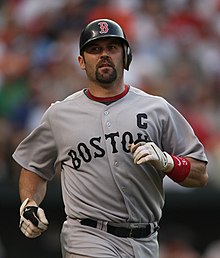
Jason Varitek, who has caught a record four no-hitters, was a selected by the American Baseball Coaches Association, Baseball America, and Collegiate Baseball.
An All-American team is an honorary sports team composed of the best amateur players of a specific season for each position—who in turn are given the honorific "All-America" and typically referred to as "All-American athletes", or simply "All-Americans". Although the honorees generally do not compete as a unit, the term is used in United States team sports to refer to players who are selected by members of the national media. Walter Camp selected the first All-America team in the early days of American football in 1889. In 1950, the American Baseball Coaches Association (ABCA) selected its first All-American baseball team. It has since chosen All-American teams and a player of the year for each division (National Collegiate Athletic Association (NCAA) Division I, Division II, Division III, National Association of Intercollegiate Athletics, junior college and high school). Collegiate Baseball selects All-American, Freshman All-American and High School All-American teams. Baseball America selects pre-season and post-season All-American teams and College Player of the Year honorees.
Various organizations selected All-American lists of the best players for the 1992 NCAA Division I college baseball season. The ABCA, the magazine Baseball America, and Collegiate Baseball were the NCAA-sanctioned selectors. This list only includes players selected to the post-season All-American first team for each selector. However, many All-American selections choose second, third, etc. teams from the remaining eligible candidates. (Full article...) -
Image 9
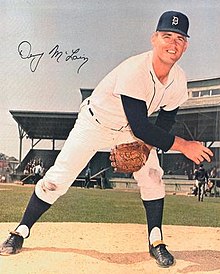
Dennis McLain, 1968 American League wins leader, with 31; this was the last time a pitcher has won thirty.
Major League Baseball recognizes the player or players in each league[a] with the most wins each season.[b] In baseball, wins are a statistic used to evaluate pitchers. Credit for a win is given by the official scorer to the pitcher whose team takes and maintains the lead while he is the pitcher of record. If a game is tied or if the lead changes to the other team, all pitchers who have participated and exited the game to that point are unable to receive credit for the victory. A starting pitcher is ineligible for the win unless he pitches at least five innings. (If he doesn't, but nevertheless leaves his team with a lead that it never relinquishes (a rather uncommon combination), the scorer would award the victory to the relief pitcher who was "most effective... in the official scorer's judgment".) (Full article...) -
Image 10
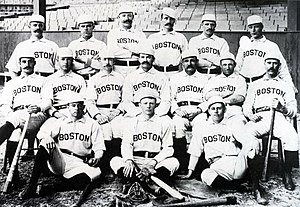
Team photograph of the 1890 Boston Reds
The Boston Reds were a Major League Baseball franchise that played in the Players' League (PL) in 1890, and one season in the American Association (AA) in 1891. In both seasons, the Reds were their league's champion, making them the second team to win back-to-back championships in two different leagues. The first franchise to accomplish this feat was the Brooklyn Bridegrooms, who won the AA championship in 1889 and the National League (NL) championship in 1890. The Reds played their home games at the Congress Street Grounds.
The Reds were an instant success on the field and in the public's opinion. The team signed several top-level players, and they played in a larger, more comfortable and modern ballpark than the Boston Beaneaters, the popular and well established cross-town rival. Player signings that first year included future Hall of Famers King Kelly, Dan Brouthers, and Charles Radbourn, along with other veterans such as Hardy Richardson, Matt Kilroy, Harry Stovey, and Tom Brown. The PL ended after one season, leaving most of its teams without a league. (Full article...) -
Image 11
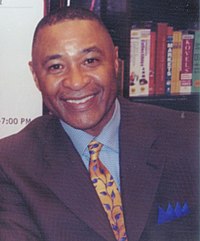
Ozzie Smith has won 13 Gold Glove Awards at shortstop, tying him for the third-highest total among winners at all positions.
The Rawlings Gold Glove Award, usually referred to as the Gold Glove, is the award given annually to the Major League Baseball players judged to have exhibited superior individual fielding performances at each fielding position in both the National League (NL) and the American League (AL), as voted by the managers and coaches in each league. Managers are not permitted to vote for their own players. Eighteen Gold Gloves are awarded each year (with the exception of 1957, 1985, 2007, and 2018), one at each of the nine positions in each league. In 1957, the baseball glove manufacturer Rawlings created the Gold Glove Award to commemorate the best fielding performance at each position. The award was created from a glove made from gold lamé-tanned leather and affixed to a walnut base. Initially, only one Gold Glove per position was awarded to the top fielder at each position in the entire league; however, separate awards were given for the National and American Leagues beginning in 1958.
Ozzie Smith, known as "the Wizard of Oz", has won the most Gold Glove Awards at shortstop; he captured 13 awards in his 19 seasons with the St. Louis Cardinals. Omar Vizquel is second among shortstops with 11 wins; he won two with the San Francisco Giants in the National League after winning nine with the Seattle Mariners and the Cleveland Indians in the American League. Luis Aparicio won nine times at shortstop for the third-highest total, followed by Mark Belanger with eight wins. Dave Concepción and Derek Jeter have won five awards; four-time winners at shortstop include Brandon Crawford, Tony Fernández, Jimmy Rollins, Andrelton Simmons and Alan Trammell. Hall of Famers who have won Gold Glove Awards at shortstop include Smith, Aparicio, Trammell, Ernie Banks, Robin Yount, Barry Larkin and Cal Ripken Jr., whose 2,632 consecutive games played earned him his "Iron Man" nickname. (Full article...) -
Image 12The Miami Marlins are a professional Major League Baseball based in Miami, Florida. The Marlins are members of the National League East division in MLB, joining in 1993 as an expansion team. In baseball, the head coach of a team is called the manager, or more formally, the field manager. The duties of the team manager include team strategy and leadership on and off the field. The Marlins have employed fifteen different managers (two interim) since their founding as the Florida Marlins in 1993, with three leading then to the postseason that has resulted in two World Series championships (1997, 2003).
The Marlins' first manager was Rene Lachemann, who led the team from its creation in 1993 through part of the 1996 season. After Cookie Rojas managed for one game, John Boles served as manager for the final 75 games of the 1996 season. Jim Leyland took over the franchise for the next two seasons, and in the process led the Marlins to their first World Series championship in 1997. In 1999, Boles took over and started his second stint as manager of the Marlins, which lasted until partway through the 2001 season. Tony Pérez was interim manager for the rest of 2001; Pérez is the only Miami Marlins manager who is a member of the National Baseball Hall of Fame, inducted as a player in 2000. (Full article...) -
Image 13
The Rays have played in Tropicana Field since their inaugural season in 1998.
The Tampa Bay Rays are a professional baseball team based in St. Petersburg, Florida. The Rays are a member of the Eastern Division of Major League Baseball's (MLB) American League (AL). Since their inaugural season in 1998, the Rays have played their home games at Tropicana Field. The team was originally known as the "Tampa Bay Devil Rays", which was inspired by a common nickname of the manta ray, but after the 2007 season, they shortened their official name to the "Tampa Bay Rays."
Tampa Bay made their Major League debut in 1998, where they were an expansion team. For their first ten seasons, Tampa Bay struggled, never had a winning record, and always finished fifth in the American League Eastern Division, except for a fourth-place finish in the 2004 season. Since 2008 however, the Rays have advanced to the postseason eight times and have played in the World Series twice, in 2008 and 2020. In 2021 the Rays achieved a 100-win regular season for the first time. (Full article...) -
Image 14
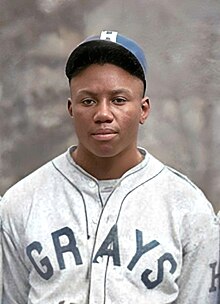
Josh Gibson is recognized as MLB's all-time batting champion with a .372 career mark, just ahead of Ty Cobb's .367.
In baseball, batting average (AVG) is a measure of a batter's success rate in achieving a hit during an at bat. In Major League Baseball (MLB), it is calculated by dividing a player's hits by his at bats (AB). In MLB, a player in each league[L] wins the "batting title" each season for having the highest batting average that year. The American League (AL) winner is known as the "Rod Carew American League Batting Champion", while the National League (NL) leader is designated the "Tony Gwynn National League Batting Champion". Since 1957, a player must have 3.1 plate appearances (PA) per scheduled game in that league (for a total of 502 over the current 162-game season) to qualify for the batting title. However, if a player's lead in AVG is sufficiently large that enough hitless at bats can be added to reach this requirement and the player still would have the highest batting average, he wins the title. Tony Gwynn, for example, had 159 hits in 451 ABs in 1996 (.353 average) but only 498 PAs. Gwynn's batting average would have dropped to .349 (159 hits in 455 ABs) with four hitless ABs added to reach the 502 PA requirement, but this would still have been higher than the next-highest eligible player (Ellis Burks with a .344 average), so he was awarded the 1996 NL batting title.
MLB officially incorporated Negro League statistics into its record book on Wednesday, May 29, 2024. On December 16, 2020, MLB announced that the records of Negro League Baseball from 1920-1948 would be designated as major league status. From 2020-2024, MLB and the Elias Sports Bureau, completed a comprehensive review of the Seamheads database in coordination with Retrosheet. The MLB database combines statistics from the Negro Leagues with existing data from the AL, NL, and other Major Leagues throughout history. As such, seven different leagues that existed during that time period are now recognized as being on the same level as MLB, which include: the Negro National League (I) (1920-1931); the Eastern Colored League (1923-1928); the American Negro League (1929); the East-West League (1932); the Negro Southern League (1932); the Negro National League (II) (1933-1948); and the Negro American League (1937-1948). (Full article...) -
Image 15

Roy Halladay made his second consecutive Opening Day start for the Phillies in 2011 against the Houston Astros.
The Philadelphia Phillies are a Major League Baseball franchise based in Philadelphia. They play in the National League East division. Also known in early franchise history as the "Philadelphia Quakers", the Phillies have used 72 different Opening Day starting pitchers in their 128 seasons. The first game of the new baseball season for a team is played on Opening Day, and being named the Opening Day starter is an honor, which is often given to the player who is expected to lead the pitching staff that season, though there are various strategic reasons why a team's best pitcher might not start on Opening Day. Where decisions are known, the 72 starters have a combined Opening Day record of 33 wins, 40 losses and 20 no decisions (33–40–20); where decisions are unknown, the team's record was 17–19. No decisions are awarded to the starting pitcher if the game is won or lost after the starting pitcher has left the game. It can also result if a starting pitcher does not pitch five full innings, even if his team retains the lead and wins.
Hall of Fame left-handed pitcher Steve Carlton has the most Opening Day starts for the Phillies, with 14, compiling a record of 3–9–2. He is followed by Robin Roberts (twelve starts; 5–6–1), Chris Short (six starts; 3–1–2), and Curt Schilling (five starts; 2–0–3). Grover Cleveland Alexander also made five Opening Day starts for the Phillies, equal to Schilling; however, no information on his decisions in those games is available. The team's record in his five Opening Day starts is 4–1. (Full article...)
More did you know
- ... that brothers George Wright and Harry Wright both managed the Providence Grays National League baseball team?
- ... that Mike Cather earned his first major-league win in an 11-inning Atlanta Braves’ win, the same night the Braves earned the National League Eastern Division title?
- ... that in 1975, his only full season, Stan Perzanowski's earned run average was the lowest on the Texas Rangers?
- ... that Josh Gibson Field in Pittsburgh, Pennsylvania, is named for Negro League star Josh Gibson, who has been called the "black Babe Ruth?"
- ... that Ryota Igarashi used to hold the Nippon Professional Baseball record for the fastest pitch thrown?
Sports portals
Selected picture

| Credit: Unknown, probably Matthew Brady or Levin Corbin Handy |
Abner Doubleday (June 26, 1819 – January 26, 1893) was a career United States Army officer and Union general in the American Civil War. He fired the first shot in defense of Fort Sumter, the opening battle of the war, and had a pivotal role in the early fighting at the Battle of Gettysburg. Gettysburg was his finest hour, but his relief by Maj. Gen. George G. Meade caused lasting enmity between the two men. In addition, he is known for a popular legend that he invented baseball, which has been debunked by almost all sports historians.
Associated Wikimedia
The following Wikimedia Foundation sister projects provide more on this subject:
-
Commons
Free media repository -
Wikibooks
Free textbooks and manuals -
Wikidata
Free knowledge base -
Wikinews
Free-content news -
Wikiquote
Collection of quotations -
Wikisource
Free-content library -
Wikiversity
Free learning tools -
Wiktionary
Dictionary and thesaurus
More portals
- Portals with triaged subpages from June 2018
- All portals with triaged subpages
- Portals with no named maintainer
- Automated article-slideshow portals with 51–100 articles in article list
- Automated article-slideshow portals with 501–1000 articles in article list
- Random portal component with 41–50 available subpages
- Automated article-slideshow portals with 201–500 articles in article list
- Random portal component with 11–15 available subpages
- Random portal component with 21–25 available image subpages





